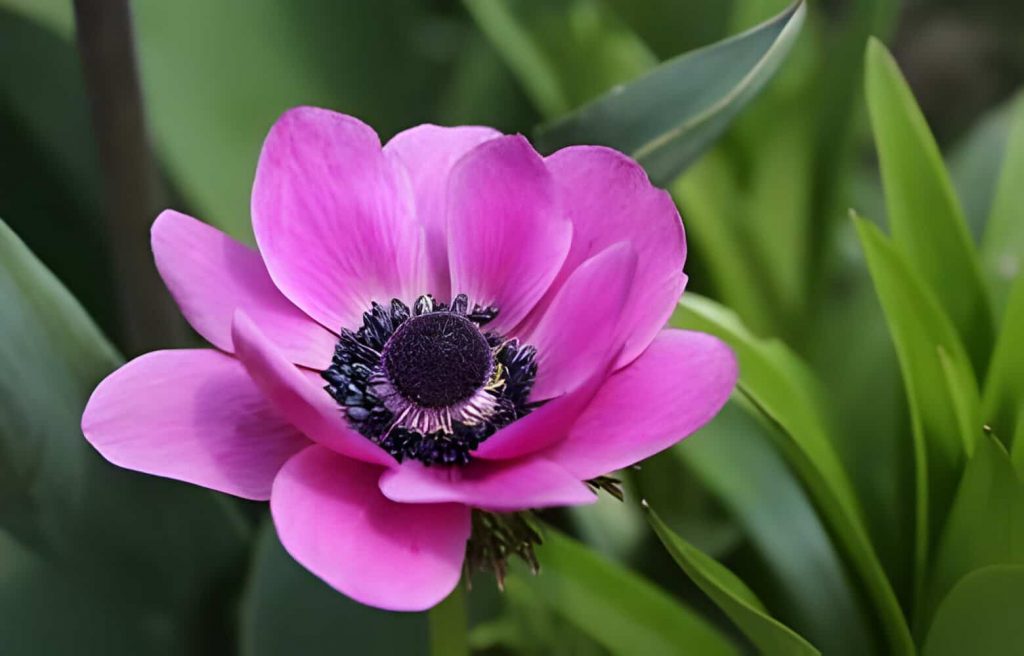
The anemone flower, with its delicate petals and vibrant colors, has captivated hearts and imaginations for centuries. But beyond its undeniable beauty, the anemone flower meaning carries a rich history and a complex symbolism.
History Of Anemone
The anemone’s story predates recorded history, with fossil evidence suggesting its existence for over 130 million years. These early ancestors lacked the vibrant colors and alluring fragrances of their modern counterparts. However, their evolution led to the development of the beautiful flowers we cherish today, playing a crucial role in attracting pollinators like insects and animals.
Meaning of Anemone Flowers

The anemone flower meaning can vary depending on the context and culture. Here’s a glimpse into some of the most prominent interpretations:
Protection
In some cultures, anemone flowers are believed to offer protection against evil and misfortune. European peasants would often carry them to ward off illness and bad luck.
Love
Anemone flowers have also been associated with love, though the sentiment can take on different shades. In ancient Greece, anemones were said to have sprung from the tears of Aphrodite, the goddess of love, symbolizing both romantic love and sorrowful loss.
Death and Forgiveness
The anemone flower meaning can also touch on themes of death and mourning. In Japanese culture, anemones are linked to the “flower of the dead” and are often used in funeral arrangements. However, the anemone flower meaning can also represent forgiveness and finding solace after loss.
Anemone Flower Color Meanings

The anemone flower, with its delicate petals and vibrant hues, offers more than just visual splendor. Each anemone flower color carries a distinct meaning, allowing you to express a specific sentiment.
White Anemones: Purity and New Beginnings
White anemones, with their pristine petals, symbolize innocence, purity, and sincerity. They are a perfect choice for bouquets expressing new beginnings, a fresh start, or a gesture of sympathy.
Red Anemones: A Spectrum of Love’s Emotions
Red anemones possess a complex and intriguing language of color. Brighter shades symbolize passionate love and anticipation of new love, while darker reds lean towards remembrance and feelings of sorrow.
Pink Anemones: A Touch of Tenderness
Soft pink anemones exude a gentle charm. Their meaning is associated with tenderness, affection, and care. A bouquet of pink anemones is a wonderful way to express your fondness and appreciation for someone special.
For Flowers for Teacher Appreciation, consider the soft pink anemone. Exuding a gentle charm, these delicate blooms hold a meaning perfectly suited for the occasion. Their symbolism is associated with tenderness, affection, and care, perfectly capturing the gratitude you feel towards your teacher. A bouquet of pink anemones is a thoughtful and beautiful way to express your fondness and appreciation for the special someone who has helped you learn and grow.tunesharemore_vert
Purple Anemones: Royalty, Wisdom, and Protection
Deep purple anemone flowers have a meaning of regality and wisdom. Their meaning is linked to royalty, luxury, and protection from negativity. A gift of purple anemones conveys a sense of respect and admiration.
Blue Anemones: Rarity and Unattainable Dreams
The elusive blue anemone flower holds a special place in the world of color meanings. It symbolizes peace, tranquility, and a touch of the unattainable, like a cherished dream yet to be realized. Evokes a sense of peace and tranquility, signifying hope and new beginnings.
Yellow Anemone
Radiates cheerfulness and optimism, perfect for brightening someone’s day.
Anemone Flower Symbolism

Victorian flower language offered a different perspective. Here, anemones, especially white ones, symbolized sincerity and purity of intentions. Red anemones took on a more hopeful meaning, signifying anticipated love and the thrill of waiting for a blossoming romance.
Beyond the Western world, anemones hold unique meanings in various cultures. In Japan, they are known as the “flower of the dead” and are often used in funeral arrangements. In contrast, some cultures associate anemones with protection against evil and misfortune. The anemone’s ability to close its petals before rain showers has also led to its symbolism of anticipation and the cyclical nature of life, representing renewal and transformation.
Anemone Cultural Significance
The windflower, aptly named for the Greek word “anemos” meaning “wind,” sways gracefully in the breeze, reflecting its delicate nature. But its cultural significance delves far deeper. Greek mythology recounts the tale of Aphrodite, the goddess of love, and her mortal love Adonis. When Adonis met his demise in a tragic hunting accident, Aphrodite’s tears, mingling with his blood, sprouted into the first crimson windflowers. This legend imbues the flower with symbolism of love, loss, and the enduring power of memory.tunesharemore_vert
Anemone Facts
Beyond its captivating history and mythology, the anemone holds a treasure trove of surprising facts. Did you know that anemones aren’t technically petals? Their colorful parts are modified sepals, serving a similar function to attract pollinators. Additionally, anemones come in a breathtaking array of colors, ranging from the classic red and white to vibrant purples, blues, and even yellows.
Uses of Anemones
The anemone’s beauty isn’t just for admiring. Throughout history, people have used various anemone species for medicinal purposes. The ancient Romans, for instance, believed anemones could treat skin conditions and fevers. However, it’s important to remember that some anemone varieties are poisonous, so using them medicinally should only be done under professional guidance. Today, anemones primarily grace our gardens and homes, their vibrant colors and delicate forms adding a touch of elegance to any space.
